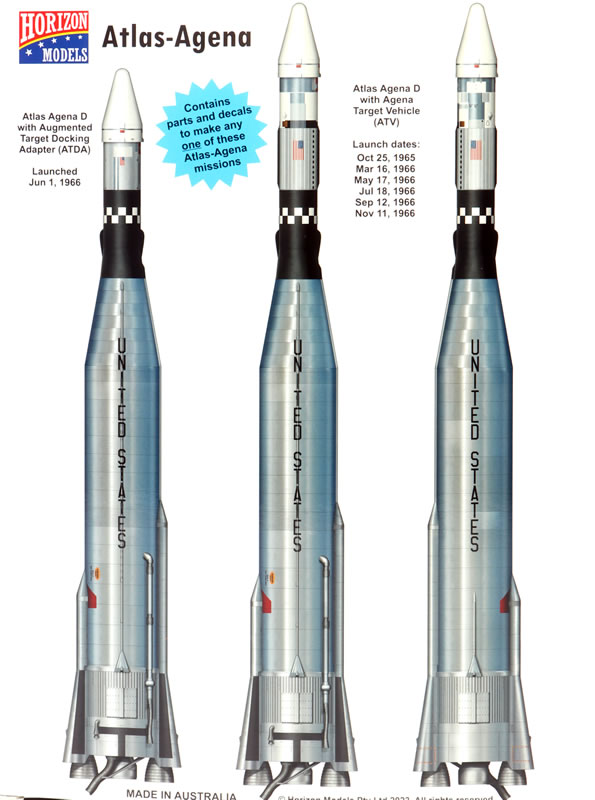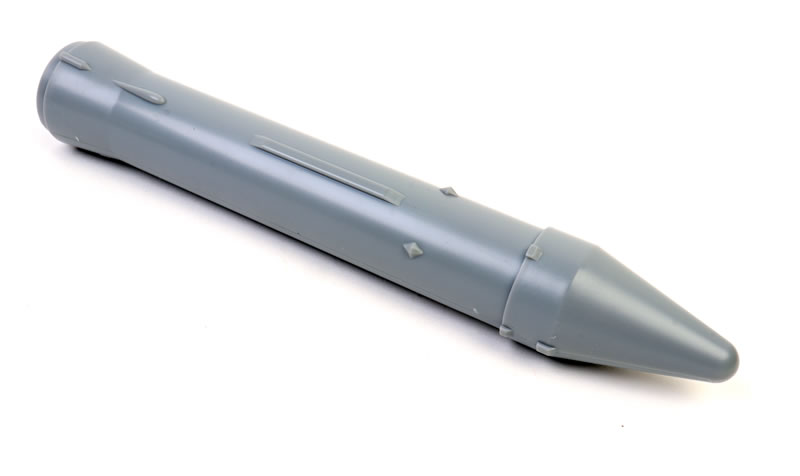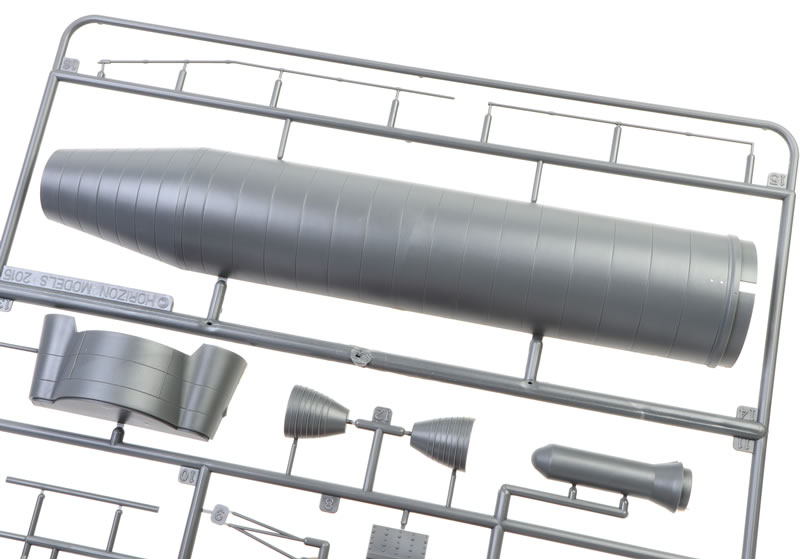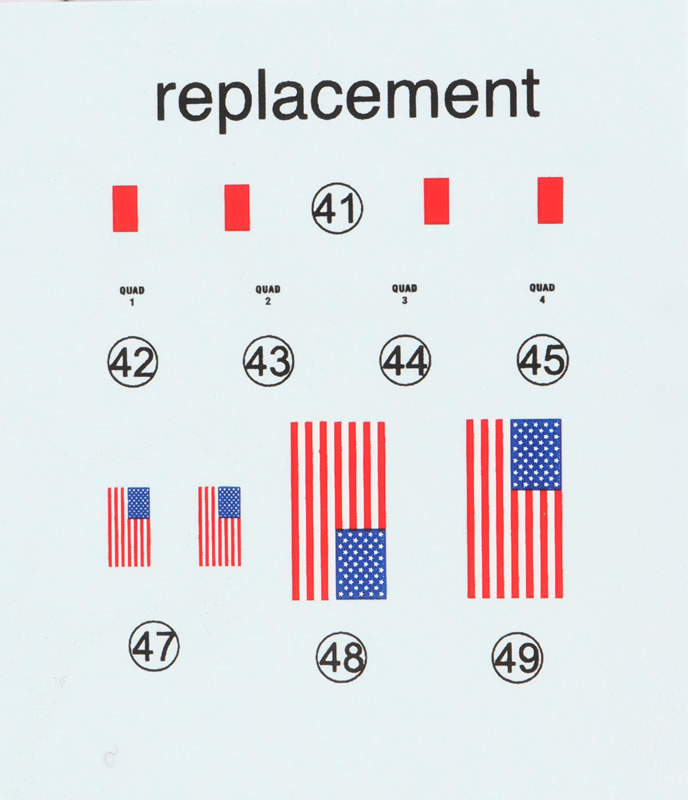Atlas-Agena

Horizon Models, 1/72 scale
S u m m a r y : |
Catalogue Number: |
Horizon Models Kit No. 2006 - Atlas Agena |
Scale: |
1/72 |
Contents & Media |
49 parts in grey injection moulded plastic (11 not used); two decal sheets for any one of seven vehicles; instructions. |
Price: |
US$41.95 plus shipping available online from Horizon Models
Shipping is fixed at USD$ 7.95 per order (for up to 6 kits) for world-wide airmail (USD$ 4.95 for postage within Australia) |
Review Type: |
First Look. |
Advantages: |
Nicely moulded; high level of detail; clear instructions; good decals; may be built with Augmented Target Docking Adaptor (ATDA) or as Agena Target Vehicle (ATG). |
Disadvantages: |
Side opening box. |
Conclusions: |
This is a cleanly moulded, well-detailed and interesting kit of a historically significant rocket. With only 38 plastic parts this should be a straightforward build. |
Reviewed by
Brett Green

The Atlas-Agena was an American expendable launch system derived from the SM-65 Atlas missile. It was a member of the Atlas family of rockets, and was launched 109 times between 1960 and 1978. It was used to launch the first five Mariner uncrewed probes to the planets Venus and Mars, and the Ranger and Lunar Orbiter uncrewed probes to the Moon. The upper stage was also used as an uncrewed orbital target vehicle for the Gemini crewed spacecraft to practice rendezvous and docking. However, the launch vehicle family was originally developed for the Air Force and most of its launches were classified DoD payloads.
The Atlas-Agena was a two-and-a-half-stage rocket, with a stage-and-a-half Atlas missile as the first stage, and an RM-81 Agena second stage. Initially, Atlas D missiles, redesignated as the LV-3, were used as the first stage. These were later replaced by the standardized Atlas SLV-3, and its derivatives, the SLV-3A and B. The final Atlas-Agena launch used an Atlas E/F.

The earliest Agena variant was the Agena A in 1959–60, which did not have restart capability. Most of these were flown on Thor-Agena boosters for the Discoverer program and only four used Atlases (Midas 1, Midas 2, Samos 1, and Samos 2), two of which failed.
Late in 1960, Lockheed introduced the uprated Agena B stage which was re-startable and had longer propellant tanks for more burn time. It first flew on the Thor and did not make its maiden voyage on an Atlas for months, when Midas 3 launched on July 12, 1961. Atlas-Agenas were then used for DoD and NASA programs, but proved a reliability nightmare as one failure after another happened. In late 1962, after Ranger 5 suffered another booster malfunction, albeit a minor one that ground controllers were able to work around, NASA convened a review board which undertook a wholesale re-evaluation of the Atlas-Agena as a launch vehicle. The board found that quality control and checkout procedures were poor, and that this situation was exacerbated by the several dozen configurations of the booster, as each individual DoD and NASA program necessitated custom modifications to the Atlas and Agena, and the latter also differed in its Atlas and Thor variants. The board recommended improved quality control, better hardware, and also establishing one standardized launch vehicle for all space programs.
The result was the Atlas SLV-3 and Agena D, standardized versions of the Atlas D core and Agena B which would be the same on every launch (at least as far as the Atlas was concerned, Agena Ds often still had customized setups, especially for DoD payloads). The Agena D first flew in July 1963 for DoD launches, but NASA continued using Agena Bs for the remaining Ranger missions. The Atlas SLV-3 meanwhile first flew in August 1964. Dozens of Atlas SLV-3/Agena D boosters were flown over the following years, mostly for the KH-7 Gambit program, also for a few NASA missions. The last Atlas-Agena was flown in 1978 to launch SEASAT, but on a repurposed Atlas F missile rather than the SLV-3.
Launches were conducted from Launch Complexes 12, 13 and 14 at the Cape Canaveral Air Force Station, and Launch Complexes 1 and 2 at Point Arguello (now SLC-3 and 4 at Vandenberg Air Force Base).
Continuing their commitment to the US Manned Spaceflight Program of the 1960s, Australian company Horizon Models has released a 1/72 scale Atlas-Agena plastic kit.

Parts are supplied to allow the model to be built with the Augmented Target Docking Adaptor (ATDA) or as Agena Target Vehicle (ATG).
Here is what Horizon Models has to say about this package:
-
Newly tooled Agena Upper Stage
-
One of two payloads can be displayed:
-
Atlas rocket features separately moulded pressure & fuel lines
-
Finely engraved recessed panel lines
-
Parts and decals included to build various Atlas-Agena missions

Horizon Models' 1/72 scale Atlas Agena comprises 49 parts in grey injection moulded plastic (11 not used), two decal sheets and an instruction sheet.
Quality of moulding is very good, certainly the equal of many mainstream model companies. Locating holes and pins are moulded in place to assist with fit and alignment. I have test fitted the Agena upper section halves and fit is perfect.

The main Atlas rocket body features really nice surface textures that should come up well after careful painting and decaling.

A small display stand is included.

With only 38 plastic parts used, this should be a fast and straightforward project.

Decals are perfectly printed by Microscale.

A small errata sheet is also included for revised US flags and other minor markings.

This is a cleanly moulded, well-detailed and interesting kit of a historically significant vehicle. With only 38 plastic parts, this should be a straightforward and enjoyable build.
Thanks to Horizon Models for the review sample.
Review Text & Images Copyright © 2024 by Brett Green
Page Created 15 April, 2024
Last updated
15 April, 2024
Back to HyperScale Main Page

|
